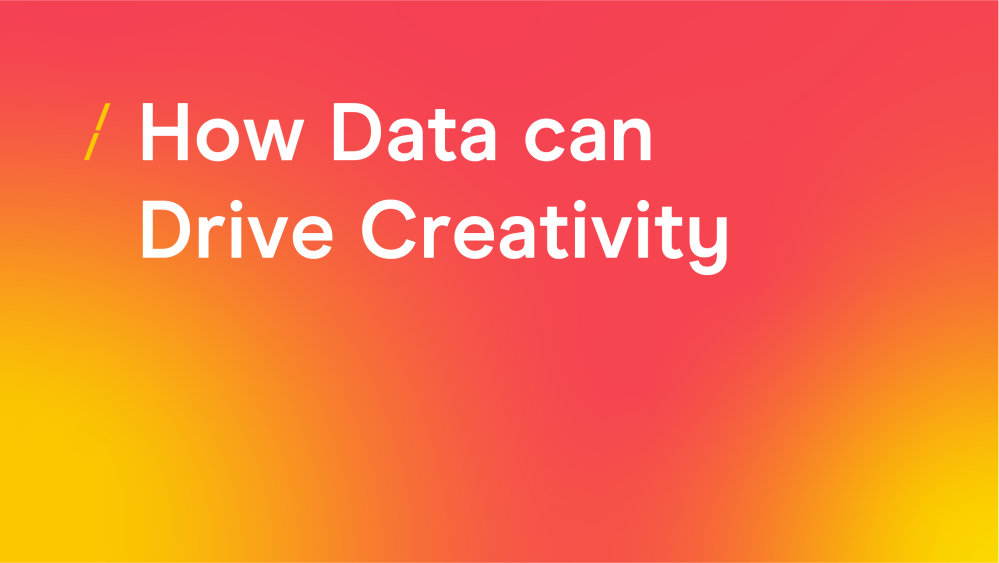How Data can Drive Creativity
13 Sep 2019

We live in a data-driven world where AI looms large, all set to automate just about everything… apart from imagination.
Against this rising tide of information, our ‘creativity’ has been seen as the last bastion – a sanctuary of our humanity.
For some, the notion of it being driven by the cold hand of science is an affront to our very nature. But for others, data is emerging as an opportunity for companies and brands to become more creative than ever.
Rather than extinguishing the empathy, emotion and instinct often seen as the guiding lights of creativity, we might be entering a world where data can actually hone it.
In a new series of articles and explorations, we’re going to consider how companies and brands across different sectors are using data to create in ways they may never have imagined.

Data-Fuelled Ideas
In the world of entertainment, film and TV execs have always used data of sorts to test ideas, traditionally in the form of focus groups where between 10 and 20 people offer their two cents.
Netflix learned what its customers like by analysing about 30 million plays a day. So, when the David Fincher-directed House of Cards was pitched to them, they looked to their data analytics. The data told them that people watched the original British version of House of Cards on a regular basis and that films directed by David Fincher were always a hit.
Finally, subscribers who tended to watch the British version of House of Cards often enjoyed Kevin Spacey films, as well as movies directed by David Fincher. To Netflix, their $100 million investment looked like a smart move from the start – and House of Cards was a home run.
For their 20th anniversary, EasyJet delved into their data to create a campaign that was a little different. And it made waves in the travel industry. They discovered personal nuggets of information about their customers’ trips over the previous 20 years, then used that info to write them personalised emails, making specific recommendations based on what they knew. They suggested places their customers might like (based on similar profiles) and inspired a little nostalgia for the past and a lot of excitement for the future. The results? Across all markets, 7.5% of EasyJet customers went on to make a booking in the next 30 days.

Fintech companies are using data to disrupt the norm right across the banking sector.
In the US, LendUp offers short-term loans for Americans with a poor credit history by using data analytics to get a more meaningful picture of potential borrowers.
As well as traditional information like demographics and credit history, their algorithm also pulls in social data from Twitter, Facebook, LinkedIn, etc. This deeper layer of data means LendUp can identify customers who are more credit-worthy than a traditional credit score suggests.
As a result, they’ve been able to unlock credit for hundreds of thousands of Americans who otherwise would have been turned away.
In retail, cosmetics brand Make Up For Ever, dug into Google data to try and find a launch strategy for a new brand.
What they discovered opened up a whole range of creative avenues. When tapping in a general complexion search like ‘best concealer’, they found that 70% of the time, queries they were related to a specific retailer (like "best concealer Estée Lauder").
However, only 33% of specific complexion searches (like "best concealer for dark skin") were related to a brand. Make Up for Ever realized that beauty brands hadn’t been connecting with multicultural audiences effectively – so they created a campaign that did.
The results paint a pretty picture: 4% lift in brand recall, an 18% jump in product searches and 11% more subscribers on their YouTube channel.

The dating app, Hinge, used data a little differently. Launched in 2013, the idea was to match friends of friends to increase the chances of finding the right match. It was built to be more than a hook-up app but its typical swipe left/ swipe right-type model meant it still felt shallow – more like a game than a place for meaningful connection.
Hinge knew that something had to change so they started communicating with users to better understand what they wanted. They found that people were matching but not connecting and 70% of them wanted something more serious, more focussed.
Hinge ditched the swiping and created ways for people to connect through personal stories on their profile pages.
They rebranded themselves as The Relationship App and used the data they had collected to launch a blisteringly poignant OOH campaign. Hinge used data to understand their customers better but that journey ended up taking them far deeper. They also came to understand themselves better, which redefined their brand purpose overall.

The Power of Data
Data offers unparalleled information into consumer audiences and behaviours that, when considered carefully, can reveal the most rewarding insights. As we mentioned at the start of this article, rather than extinguishing the empathy, emotion, and instinct of our creativity, we are entering a world where data can actually hone them.
Find out more about the Customer Engagement campaign here.
Please login to comment.
Comments